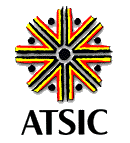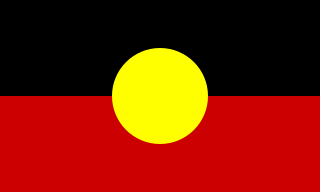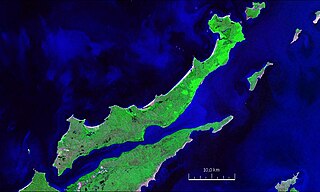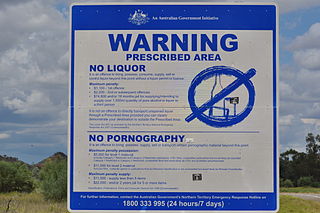Related Research Articles

The Aboriginal and Torres Strait Islander Commission (ATSIC) (1990–2005) was the Australian Government body through which Aboriginal Australians and Torres Strait Islanders were formally involved in the processes of government affecting their lives, established under the Hawke government in 1990. A number of Indigenous programs and organisations fell under the overall umbrella of ATSIC.
The Office of Indigenous Policy Coordination (OIPC) was the Australian Government-led unit for the coordination of policy, programs and services for Indigenous Australians from July 2004 to August 2011.

Aboriginal Australians are the various Indigenous peoples of the Australian mainland and many of its islands, but excluding the ethnically distinct people of the Torres Strait Islands. The term "Indigenous Australians" is applied to Aboriginal Australians and Torres Strait Islanders collectively.
The Cape York Institute for Policy and Leadership, also known as the Cape York Institute, is an Australian public policy organisation which researches and implements welfare reforms to reduce social inequalities between Indigenous and Non-Indigenous peoples living in Cape York. The Cape York Institute was founded by lawyer, academic and Indigenous welfare advocate Noel Pearson. Established in July 2004, the organisation was developed in collaboration with the people of Cape York and Griffith University. The Institute prepares reports and submissions to the Australian Federal Government, identifying priority areas of welfare and economic reform to restore social norms within the Cape York communities. To deliver welfare and economic reform, the Institute engages with a number of partner organisations including the Cape York Partnerships, Family Responsibilities Commission, Balkanu Cape York Development Corporation and the Cape York Aboriginal Australian Academy. The Cape York Institute receives Commonwealth and Queensland State Government funding to support Welfare Reform Projects in areas of Indigenous education, employment, families and housing.
An outstation, homeland or homeland community is a very small, often remote, permanent community of Aboriginal Australian people connected by kinship, on land that often, but not always, has social, cultural or economic significance to them, as traditional land. The outstation movement or homeland movement refers to the voluntary relocation of Aboriginal people from towns to these locations.
Hearing Australia is a statutory authority constituted under the Australian Hearing Services Act 1991. Hearing Australia is the largest provider of government-funded hearing services in Australia. One of their areas of interest is hearing testing and rehabilitation of children under the age of 26.

Elcho Island, known to its traditional owners as Galiwin'ku (Galiwinku) is an island off the coast of Arnhem Land, in the Northern Territory of Australia. It is located at the southern end of the Wessel Islands group located in the East Arnhem Region. Galiwin'ku is also the name of the settlement where the island's largest community lives. Elcho Island formed part of the traditional lands of the Yan-nhaŋu, according to Norman Tindale. According to J. C. Jennison, the Aboriginal inhabitants were the Dhuwal, who called themselves the Kokalango Mala

The Australian National Aboriginal and Torres Strait Islander Education Policy (AEP) is a national policy adopted by the Government of Australia by each State and Territory government. The policy was first introduced in 1989 and is the foundation of education programs for all Indigenous Australians.
Indigenous Australian self-determination, also known as Aboriginal Australian self-determination, is the power relating to self-governance by Aboriginal and Torres Strait Islander peoples in Australia. It is the right of Aboriginal and Torres Strait Islander peoples to determine their own political status and pursue their own economic, social and cultural interests. Self-determination asserts that Aboriginal and Torres Strait Islander peoples should direct and implement Aboriginal and Torres Strait Islander policy formulation and provision of services. Self-determination encompasses both Aboriginal land rights and self-governance, and may also be supported by a treaty between a government and an Indigenous group in Australia.

Tania Major is an Aboriginal activist who first came to prominence in 2004 as the youngest person elected to the Aboriginal and Torres Strait Islander Commission (ATSIC).

Amata is an Aboriginal community in the Anangu Pitjantjatjara Yankunytjatjara Lands in South Australia, comprising one of the six main communities on "The Lands".
Indigenous Australians are people with familial heritage from, and membership in, the ethnic groups that lived in areas within the Australian continent before British colonisation. They consist of two distinct groups: the Aboriginal peoples of the Australian mainland and Tasmania, and the Torres Strait Islander peoples from the seas between Queensland and Papua New Guinea. The term Aboriginal and Torres Strait Islander peoples or the person's specific cultural group, is often preferred, though the terms First Nations of Australia, First Peoples of Australia and First Australians are also increasingly common; 812,728 people self-identified as being of Aboriginal and/or Torres Strait Islander origin in the 2021 Australian Census, representing 3.2% of the total population of Australia. Of these Indigenous Australians, 91.4% identified as Aboriginal; 4.2% identified as Torres Strait Islander; while 4.4% identified with both groups. Since 1995, the Australian Aboriginal flag and the Torres Strait Islander flag have been official flags of Australia.

The Northern Territory National Emergency Response, also known as "The Intervention" or the Northern Territory Intervention, and sometimes the abbreviation "NTER" was a package of measures enforced by legislation affecting Indigenous Australians in the Northern Territory (NT) of Australia, which lasted from 2007 until 2012. The measures included restrictions on the consumption of alcohol and pornography, changes to welfare payments, and changes to the delivery and management of education, employment and health services in the Territory.

An Indigenous Protected Area (IPA) is a class of protected area used in Australia; each is formed by voluntary agreement with Indigenous Australians, and declared by Aboriginal Australians and Torres Strait Islander representative organisations. Each is formally recognised by the Australian Government as being part of its National Reserve System. The areas may comprise land and sea, and are managed by Indigenous groups for the conservation of biodiversity. Managing IPAs also helps to protect the cultural values of their country for future generations, and has benefits for Indigenous health, education, economic and social cohesion.

The Torres Strait Regional Authority is an Australian Government body established in 1994 to administer the Torres Strait Islands. It consists of 20 elected representatives. The primary function of the authority is to strengthen the economic, social and cultural development of the peoples of the Torres Strait area.
The National Rural Health Alliance (NRHA) is Australia's peak non-government organisation for rural and remote health.
The Department of Social Security was a government department in Australia, which administered the Social Security system between 1972 and 1998. The department was one of several new departments established by the Whitlam government and was managed by the Minister for Social Security.
The Stronger Futures policy is a multifaceted social policy of the Australian government concerning the Aboriginal population of the Northern Territory. It is underpinned by the Stronger Futures in the Northern Territory Act 2012, which ceases to have effect 10 years after its commencement on 29 June 2012.

Indigenous health in Australia examines health and wellbeing indicators of Indigenous Australians compared with the rest of the population. Statistics indicate that Aboriginal Australians and Torres Strait Islanders are much less healthy than other Australians. Various government strategies have been put into place to try to remediate the problem; there has been some improvement in several areas, but statistics between Indigenous Australians and the rest of the Australian population still show unacceptable levels of difference.
The Indigenous ranger projects were introduced by the Australian Government in 2007 as part of its Working on Country program. Indigenous rangers are Indigenous Australians who combine traditional knowledge with conservation training in order to protect and manage their land, sea and culture. Many rangers are employed both in Indigenous Protected Areas (IPAs) and other parts of Australia, including the Torres Strait Islands and other islands. Aboriginal and Torres Strait Islander men and women employed as rangers have reported benefits to wellbeing and as well as benefiting their own and the wider Australian community.
References
- ↑ "Community Development Employment Projects (CDEP)". Centrelink.gov.au. Retrieved 20 May 2012.
- 1 2 Altman, Jon (April 2017). "When Homelands Were Celebrated" (PDF). Land Rights News (Northern Edition). Northern Land Council (2): 9–11. Retrieved 16 August 2020.
- ↑ Palmer, Kingsley (January 2016). "10. Homelands as outstations of public policy". In Peterson, Nicolas; Myers, Fred (eds.). Experiments in self-determination: Histories of the outstation movement in Australia. Monographs in Anthropology. ANU Press. p. 186. ISBN 9781925022902 . Retrieved 16 August 2020.